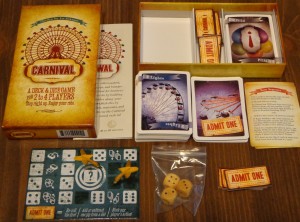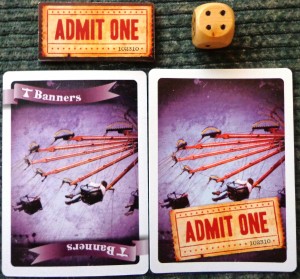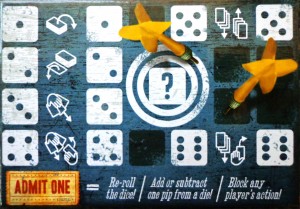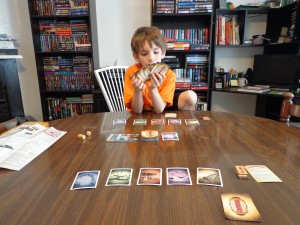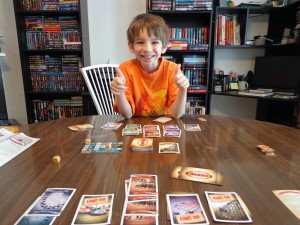I’m not a fan of carnivals. They’re loud, there’s a lot of people, and there are clowns. Lots and lots of clowns. Sometimes, they even have Volkswagens. They just keep sending them in. I don’t know who “they” are, but I’d wish they’d stop. If mankind needed a savior, now would be the time. Anyway, I digress…Carnival.
Carnival is a card game that tasks players with being the first one to build four out of the five possible rides. Players will be taking turns rolling dice and performing various actions, which include swapping cards with players (among other things) in order to help them reach their goal. Before I get into specifics, I’d like to thank Dan Yarrington from Game Salute for sending me a free copy to review.
Components
Cards – There are Parts cards, Wild cards, and Midway cards. Players will be attempting to assemble their rides using part cards of the same color, which consist of banners, lights, materials, and seats. Wild cards can be used to represent whichever part card players might need, and midway cards serve as the base for the rides…players start with all five midway cards automatically. Reference cards are also available to help players to stay on track.
Tickets – Players can use tickets to perform special actions, such as to protect themselves from another action or to tweak their die roll, just to name a few examples.
Dice & Tableau – Players roll three dice every turn to determine what actions they are allowed to take. Some of those dice are then assigned to the Tableau, which lists out all of the actions that players can take.
Setup & Gameplay
Before anything happens, the white-tipped ribbon cards need removed from the game if there are two or three people playing. Each player receives one wild card, five unique colored midway cards (ticket side facedown), and three tickets. After that, the parts and wild cards are shuffled and players are dealt five cards from the deck. A discard pile is started, the number of cards drawn from the deck being equal to the number of players playing the game.
On a player’s turn, they will perform the following:
1) Create a discard pile if none exists by taking the top card from the deck.
2) Discard down to a six card hand size.
3) Discard a wild card (from either their hand or midway) along with any number of cards from their hand to draw new cards -OR- Roll three dice and perform two actions by assigning those dice to the tableau.
4) Play cards from their hand to start a ride or build on an existing one. Starting a new ride requires a two parts minimum, though one of those cards can be a wild card. If a ride is completed by collecting four parts, then the midway card along with the stack is flipped over to reveal the midway card’s ticket side and a ticket is awarded to the player, assuming that they have less than three in their possession.
5) Draw up to a hand size of three cards, if needed.
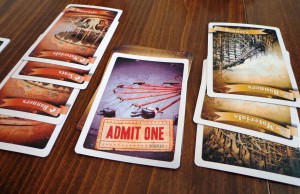
Completing rides early on can be easy, but becomes harder as the game goes on as you’re often stuck with cards in your hand that you no longer need.
Dice roll actions will help players acquire the cards they need to complete their rides. Actions include drawing from the deck, drawing from the discard pile, taking a random card from another player’s hand, swapping a card from their hand for a random card in their opponent’s hand, trading a midway card for their opponent’s midway card, and stealing a midway card from an opponent after discarding a card from their hand.
Tickets can do a number of things to help players out when needed. For one, they can be traded in (one per turn) to add or subtract a pip on a die or to reroll the entire set. They can also block someone else from performing an action against you. Players only start with three and cannot have more than three, so they should be used sparingly and only when needed.
The winner of the game is the first person to complete four of the five rides.
The above doesn’t touch on all of the rules, but should give you an idea as to what the game is like. To see the rules in greater detail, you can check out the manual here:
The Review
First, I wanted to commend this game for having such a variety of variants available. Some variants are listed in the manual and some variants are listed on the Dice Hate Me Games website, which I’ll link later on. My favorite variant ended up being the “Quick Play” which allows a player to win after completing three rides instead of four. It turns out to be very helpful for when there isn’t a lot of time to play a game together. Other variants introduce the possibility of teams, allowing two teams of two to compete against one another.
I really liked the color scheme and the feel of the cards…they were very sharp. However, if there was one thing about them that I could change, it would be to put a unique graphic on the individual part cards. For example, on all of the banner cards, put a banner or something to that effect. At present, the text can be difficult to read from across the table when trying to trade cards with other players. I really would have liked to see what someone has at a glance without having to ask them what they have on their midway cards.
The tableau was an interesting mechanic, reminding me a little of Alien Frontiers. In both games, you roll dice and assign those dice to do various things. It was interesting to see how that kind of mechanic could work with cards and I was pleasantly surprised by the outcome. While there are only six actions on the tableau, they are varied enough to provide players with a sense of choice, with each one affecting their current standing in different ways.
Vinnie (11) enjoyed the theme of the game as well as gathering the cards he needed to assemble his rides. He was able to make well-informed decisions without my guidance and coaching. He also gave careful thought to his dice rolls to see which actions would benefit him the most. His behavior was fairly aggressive and he often opted to perform the actions that would take cards from me, which proved to slow me down while strengthening his own position. I, on the other hand, played conservatively and opted for the actions that would guarantee me particular cards as I hate the randomness of the draw. The discard pile was often my target, and even used a ticket or two to ensure that I’d earn the dice roll of two that I needed to get that precious card into my hand.
Overall, Carnival is a light to moderate card game well worth looking into. It’s light in the sense that it doesn’t take long to play, but moderate in the sense that it has enough depth and variety to keep players thinking about their next move…and best of all, NO CLOWNS!!!
Final Verdict: 8/10
—
You can learn more about Carnival by visiting the following websites:
—

